BSBFIM601 Manage Finance Assignment: Financial Reporting and Taxation
VerifiedAdded on 2022/11/29
|18
|3292
|241
Homework Assignment
AI Summary
This assignment addresses key aspects of financial management, including financial probity, fraudulent behavior, and the requirements for audited accounts. It explores cash and accrual accounting principles, outlining their advantages and disadvantages. The assignment also covers taxation and superannuation obligations for businesses, detailing the Australian Business Number (ABN), Goods and Services Tax (GST), Pay As You Go (PAYG), and Fringe Benefits Tax (FBT). Additionally, it examines the requirements for financial reporting and auditing under the Corporations Act 2001, including those for registered foreign companies. The document further includes a profit and loss statement, a cash flow statement, and a budget statement analysis, providing practical application of financial concepts. Finally, the document discusses GST reporting processes and withholding obligations for employees and contractors.

Running head - MANAGE FINANCE
Manage Finance
Name of the student
Name of the university
Author’s note
Manage Finance
Name of the student
Name of the university
Author’s note
Paraphrase This Document
Need a fresh take? Get an instant paraphrase of this document with our AI Paraphraser
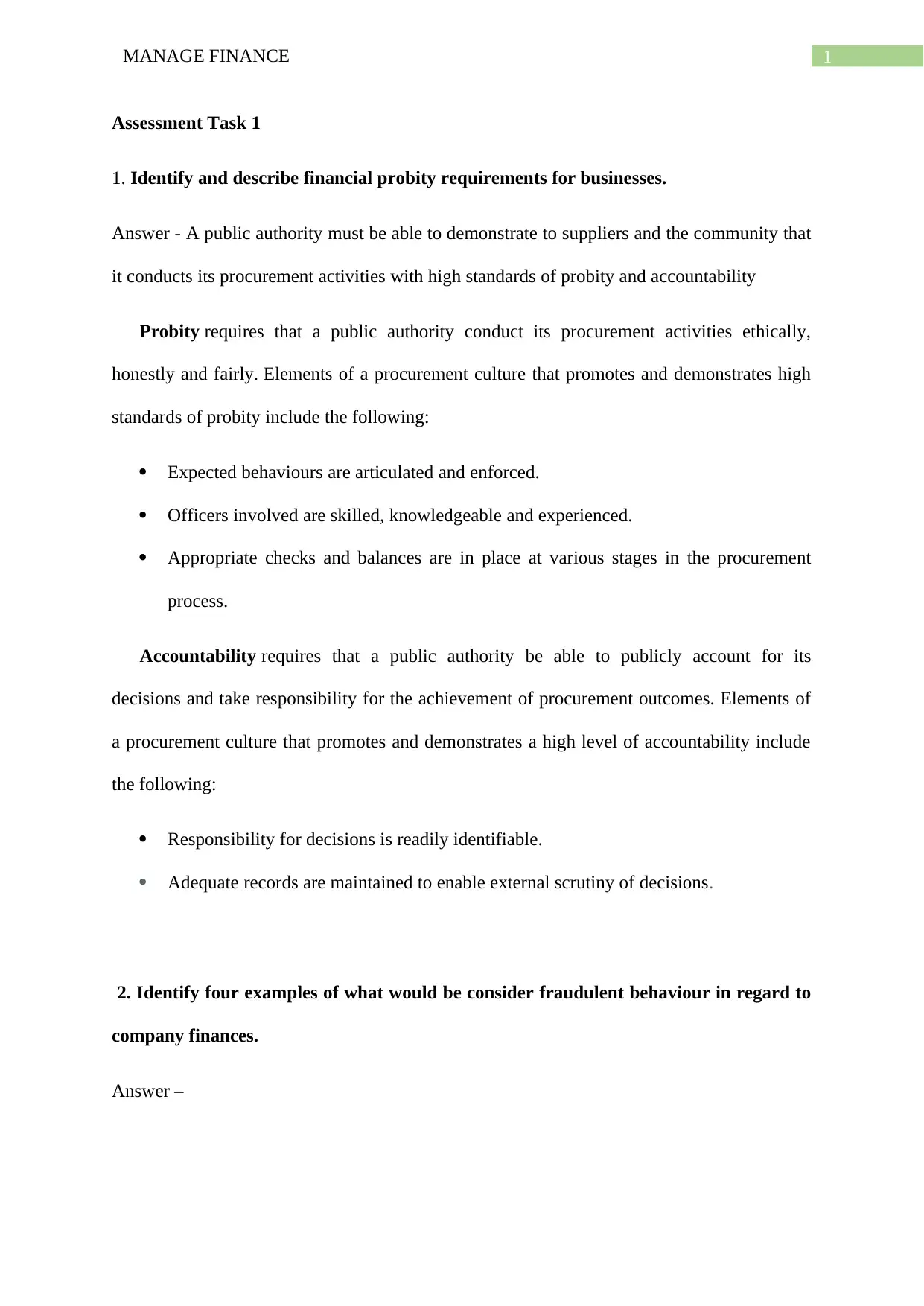
1MANAGE FINANCE
Assessment Task 1
1. Identify and describe financial probity requirements for businesses.
Answer - A public authority must be able to demonstrate to suppliers and the community that
it conducts its procurement activities with high standards of probity and accountability
Probity requires that a public authority conduct its procurement activities ethically,
honestly and fairly. Elements of a procurement culture that promotes and demonstrates high
standards of probity include the following:
Expected behaviours are articulated and enforced.
Officers involved are skilled, knowledgeable and experienced.
Appropriate checks and balances are in place at various stages in the procurement
process.
Accountability requires that a public authority be able to publicly account for its
decisions and take responsibility for the achievement of procurement outcomes. Elements of
a procurement culture that promotes and demonstrates a high level of accountability include
the following:
Responsibility for decisions is readily identifiable.
Adequate records are maintained to enable external scrutiny of decisions.
2. Identify four examples of what would be consider fraudulent behaviour in regard to
company finances.
Answer –
Assessment Task 1
1. Identify and describe financial probity requirements for businesses.
Answer - A public authority must be able to demonstrate to suppliers and the community that
it conducts its procurement activities with high standards of probity and accountability
Probity requires that a public authority conduct its procurement activities ethically,
honestly and fairly. Elements of a procurement culture that promotes and demonstrates high
standards of probity include the following:
Expected behaviours are articulated and enforced.
Officers involved are skilled, knowledgeable and experienced.
Appropriate checks and balances are in place at various stages in the procurement
process.
Accountability requires that a public authority be able to publicly account for its
decisions and take responsibility for the achievement of procurement outcomes. Elements of
a procurement culture that promotes and demonstrates a high level of accountability include
the following:
Responsibility for decisions is readily identifiable.
Adequate records are maintained to enable external scrutiny of decisions.
2. Identify four examples of what would be consider fraudulent behaviour in regard to
company finances.
Answer –
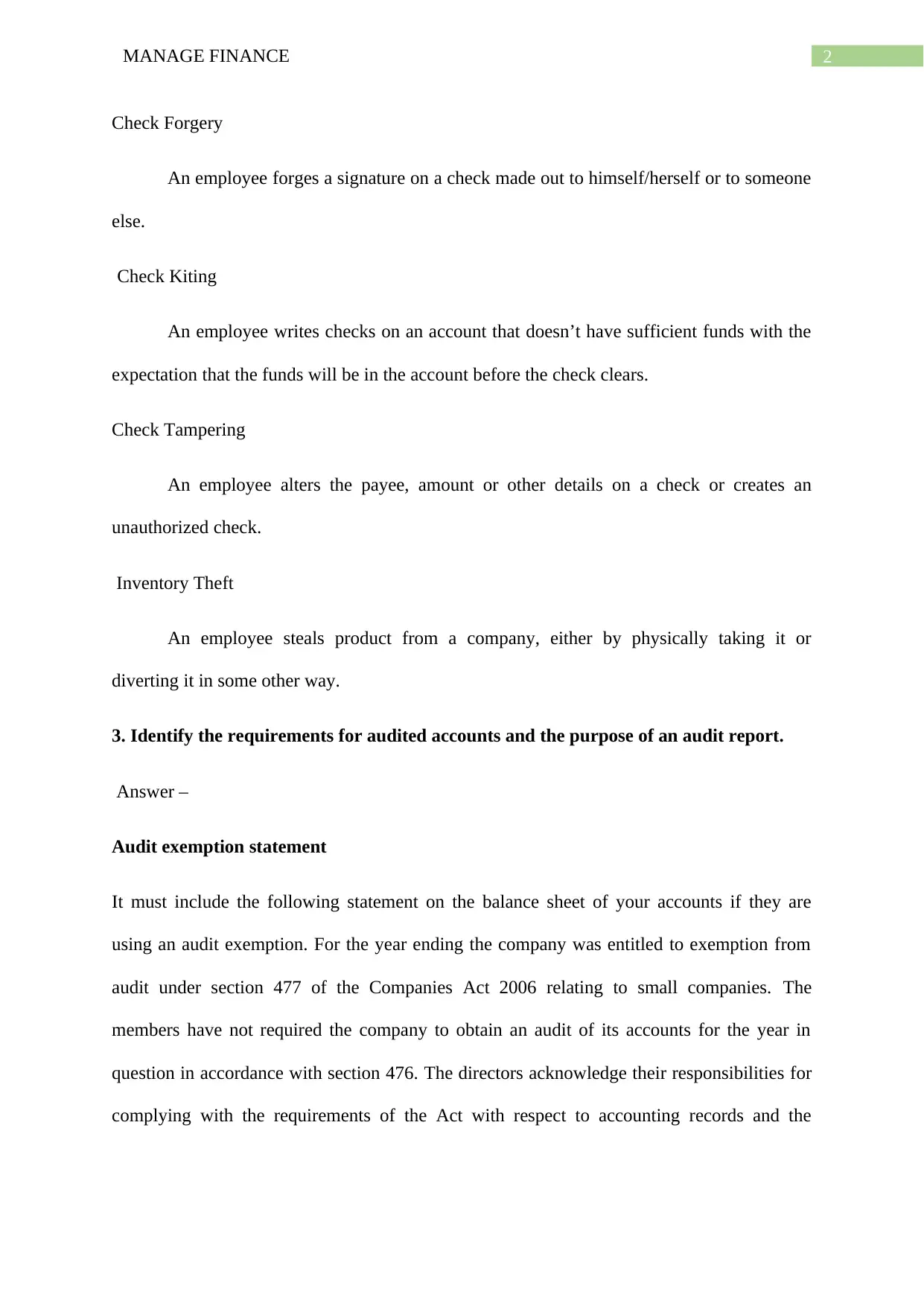
2MANAGE FINANCE
Check Forgery
An employee forges a signature on a check made out to himself/herself or to someone
else.
Check Kiting
An employee writes checks on an account that doesn’t have sufficient funds with the
expectation that the funds will be in the account before the check clears.
Check Tampering
An employee alters the payee, amount or other details on a check or creates an
unauthorized check.
Inventory Theft
An employee steals product from a company, either by physically taking it or
diverting it in some other way.
3. Identify the requirements for audited accounts and the purpose of an audit report.
Answer –
Audit exemption statement
It must include the following statement on the balance sheet of your accounts if they are
using an audit exemption. For the year ending the company was entitled to exemption from
audit under section 477 of the Companies Act 2006 relating to small companies. The
members have not required the company to obtain an audit of its accounts for the year in
question in accordance with section 476. The directors acknowledge their responsibilities for
complying with the requirements of the Act with respect to accounting records and the
Check Forgery
An employee forges a signature on a check made out to himself/herself or to someone
else.
Check Kiting
An employee writes checks on an account that doesn’t have sufficient funds with the
expectation that the funds will be in the account before the check clears.
Check Tampering
An employee alters the payee, amount or other details on a check or creates an
unauthorized check.
Inventory Theft
An employee steals product from a company, either by physically taking it or
diverting it in some other way.
3. Identify the requirements for audited accounts and the purpose of an audit report.
Answer –
Audit exemption statement
It must include the following statement on the balance sheet of your accounts if they are
using an audit exemption. For the year ending the company was entitled to exemption from
audit under section 477 of the Companies Act 2006 relating to small companies. The
members have not required the company to obtain an audit of its accounts for the year in
question in accordance with section 476. The directors acknowledge their responsibilities for
complying with the requirements of the Act with respect to accounting records and the
⊘ This is a preview!⊘
Do you want full access?
Subscribe today to unlock all pages.

Trusted by 1+ million students worldwide
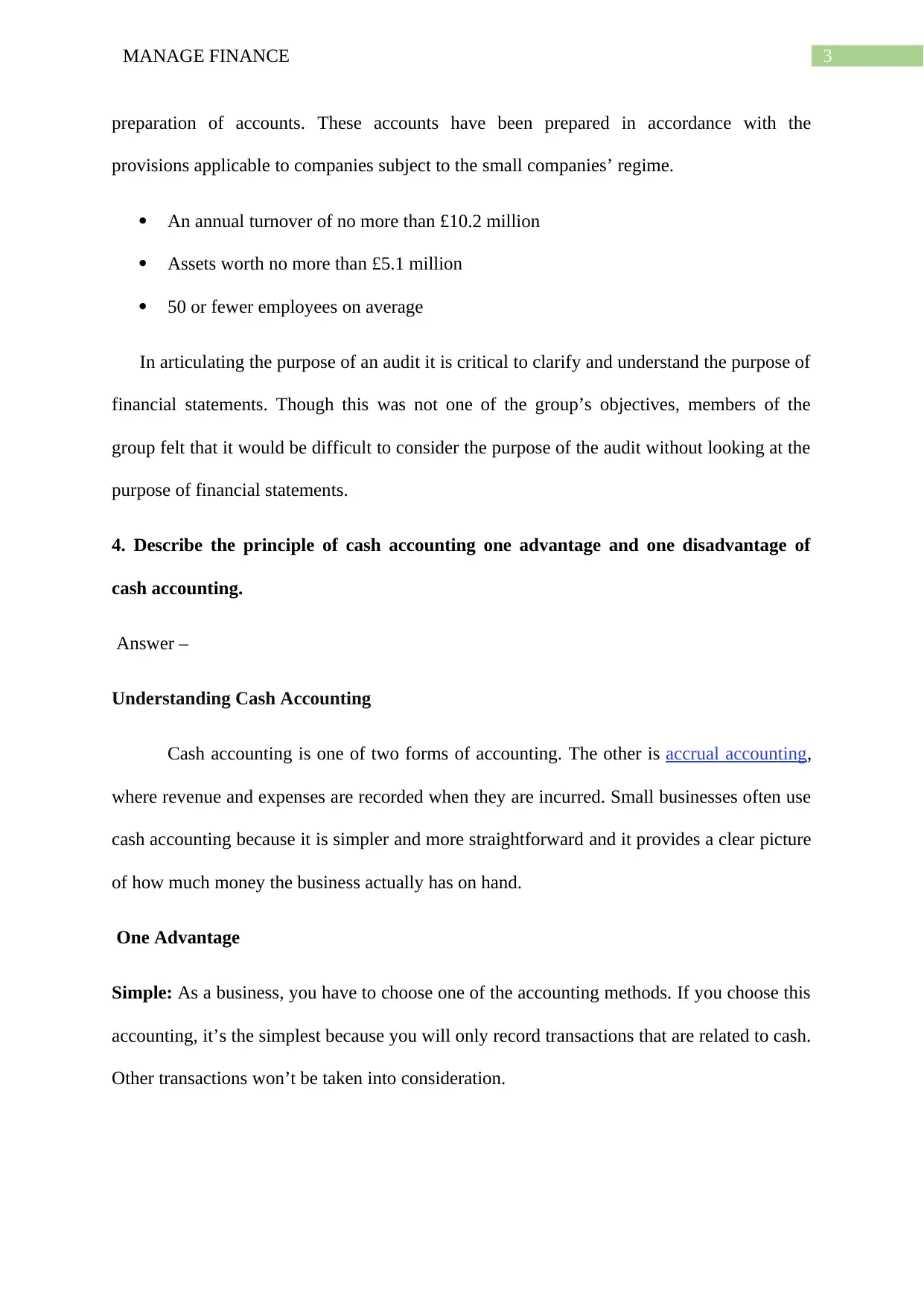
3MANAGE FINANCE
preparation of accounts. These accounts have been prepared in accordance with the
provisions applicable to companies subject to the small companies’ regime.
An annual turnover of no more than £10.2 million
Assets worth no more than £5.1 million
50 or fewer employees on average
In articulating the purpose of an audit it is critical to clarify and understand the purpose of
financial statements. Though this was not one of the group’s objectives, members of the
group felt that it would be difficult to consider the purpose of the audit without looking at the
purpose of financial statements.
4. Describe the principle of cash accounting one advantage and one disadvantage of
cash accounting.
Answer –
Understanding Cash Accounting
Cash accounting is one of two forms of accounting. The other is accrual accounting,
where revenue and expenses are recorded when they are incurred. Small businesses often use
cash accounting because it is simpler and more straightforward and it provides a clear picture
of how much money the business actually has on hand.
One Advantage
Simple: As a business, you have to choose one of the accounting methods. If you choose this
accounting, it’s the simplest because you will only record transactions that are related to cash.
Other transactions won’t be taken into consideration.
preparation of accounts. These accounts have been prepared in accordance with the
provisions applicable to companies subject to the small companies’ regime.
An annual turnover of no more than £10.2 million
Assets worth no more than £5.1 million
50 or fewer employees on average
In articulating the purpose of an audit it is critical to clarify and understand the purpose of
financial statements. Though this was not one of the group’s objectives, members of the
group felt that it would be difficult to consider the purpose of the audit without looking at the
purpose of financial statements.
4. Describe the principle of cash accounting one advantage and one disadvantage of
cash accounting.
Answer –
Understanding Cash Accounting
Cash accounting is one of two forms of accounting. The other is accrual accounting,
where revenue and expenses are recorded when they are incurred. Small businesses often use
cash accounting because it is simpler and more straightforward and it provides a clear picture
of how much money the business actually has on hand.
One Advantage
Simple: As a business, you have to choose one of the accounting methods. If you choose this
accounting, it’s the simplest because you will only record transactions that are related to cash.
Other transactions won’t be taken into consideration.
Paraphrase This Document
Need a fresh take? Get an instant paraphrase of this document with our AI Paraphraser
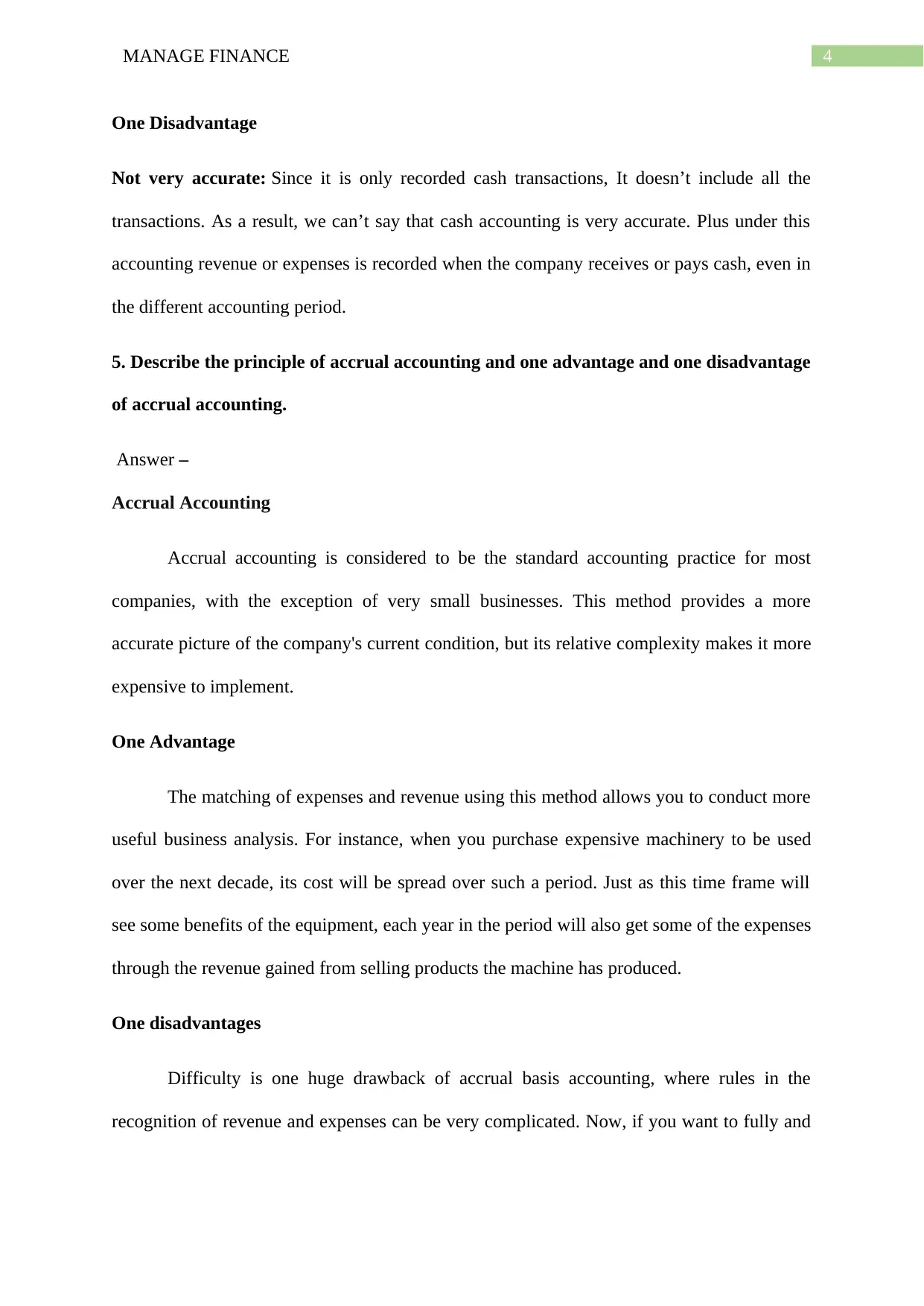
4MANAGE FINANCE
One Disadvantage
Not very accurate: Since it is only recorded cash transactions, It doesn’t include all the
transactions. As a result, we can’t say that cash accounting is very accurate. Plus under this
accounting revenue or expenses is recorded when the company receives or pays cash, even in
the different accounting period.
5. Describe the principle of accrual accounting and one advantage and one disadvantage
of accrual accounting.
Answer –
Accrual Accounting
Accrual accounting is considered to be the standard accounting practice for most
companies, with the exception of very small businesses. This method provides a more
accurate picture of the company's current condition, but its relative complexity makes it more
expensive to implement.
One Advantage
The matching of expenses and revenue using this method allows you to conduct more
useful business analysis. For instance, when you purchase expensive machinery to be used
over the next decade, its cost will be spread over such a period. Just as this time frame will
see some benefits of the equipment, each year in the period will also get some of the expenses
through the revenue gained from selling products the machine has produced.
One disadvantages
Difficulty is one huge drawback of accrual basis accounting, where rules in the
recognition of revenue and expenses can be very complicated. Now, if you want to fully and
One Disadvantage
Not very accurate: Since it is only recorded cash transactions, It doesn’t include all the
transactions. As a result, we can’t say that cash accounting is very accurate. Plus under this
accounting revenue or expenses is recorded when the company receives or pays cash, even in
the different accounting period.
5. Describe the principle of accrual accounting and one advantage and one disadvantage
of accrual accounting.
Answer –
Accrual Accounting
Accrual accounting is considered to be the standard accounting practice for most
companies, with the exception of very small businesses. This method provides a more
accurate picture of the company's current condition, but its relative complexity makes it more
expensive to implement.
One Advantage
The matching of expenses and revenue using this method allows you to conduct more
useful business analysis. For instance, when you purchase expensive machinery to be used
over the next decade, its cost will be spread over such a period. Just as this time frame will
see some benefits of the equipment, each year in the period will also get some of the expenses
through the revenue gained from selling products the machine has produced.
One disadvantages
Difficulty is one huge drawback of accrual basis accounting, where rules in the
recognition of revenue and expenses can be very complicated. Now, if you want to fully and
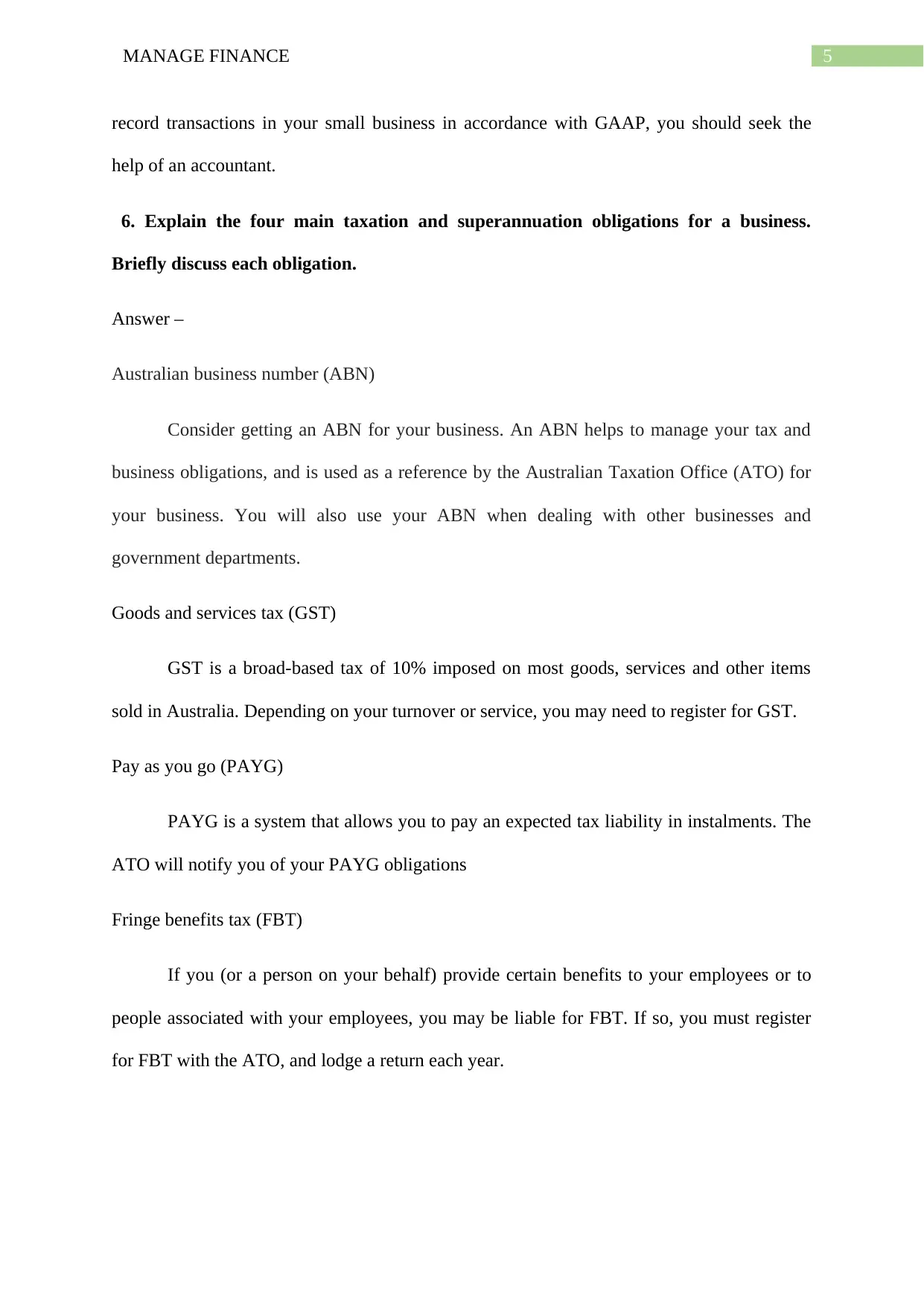
5MANAGE FINANCE
record transactions in your small business in accordance with GAAP, you should seek the
help of an accountant.
6. Explain the four main taxation and superannuation obligations for a business.
Briefly discuss each obligation.
Answer –
Australian business number (ABN)
Consider getting an ABN for your business. An ABN helps to manage your tax and
business obligations, and is used as a reference by the Australian Taxation Office (ATO) for
your business. You will also use your ABN when dealing with other businesses and
government departments.
Goods and services tax (GST)
GST is a broad-based tax of 10% imposed on most goods, services and other items
sold in Australia. Depending on your turnover or service, you may need to register for GST.
Pay as you go (PAYG)
PAYG is a system that allows you to pay an expected tax liability in instalments. The
ATO will notify you of your PAYG obligations
Fringe benefits tax (FBT)
If you (or a person on your behalf) provide certain benefits to your employees or to
people associated with your employees, you may be liable for FBT. If so, you must register
for FBT with the ATO, and lodge a return each year.
record transactions in your small business in accordance with GAAP, you should seek the
help of an accountant.
6. Explain the four main taxation and superannuation obligations for a business.
Briefly discuss each obligation.
Answer –
Australian business number (ABN)
Consider getting an ABN for your business. An ABN helps to manage your tax and
business obligations, and is used as a reference by the Australian Taxation Office (ATO) for
your business. You will also use your ABN when dealing with other businesses and
government departments.
Goods and services tax (GST)
GST is a broad-based tax of 10% imposed on most goods, services and other items
sold in Australia. Depending on your turnover or service, you may need to register for GST.
Pay as you go (PAYG)
PAYG is a system that allows you to pay an expected tax liability in instalments. The
ATO will notify you of your PAYG obligations
Fringe benefits tax (FBT)
If you (or a person on your behalf) provide certain benefits to your employees or to
people associated with your employees, you may be liable for FBT. If so, you must register
for FBT with the ATO, and lodge a return each year.
⊘ This is a preview!⊘
Do you want full access?
Subscribe today to unlock all pages.

Trusted by 1+ million students worldwide
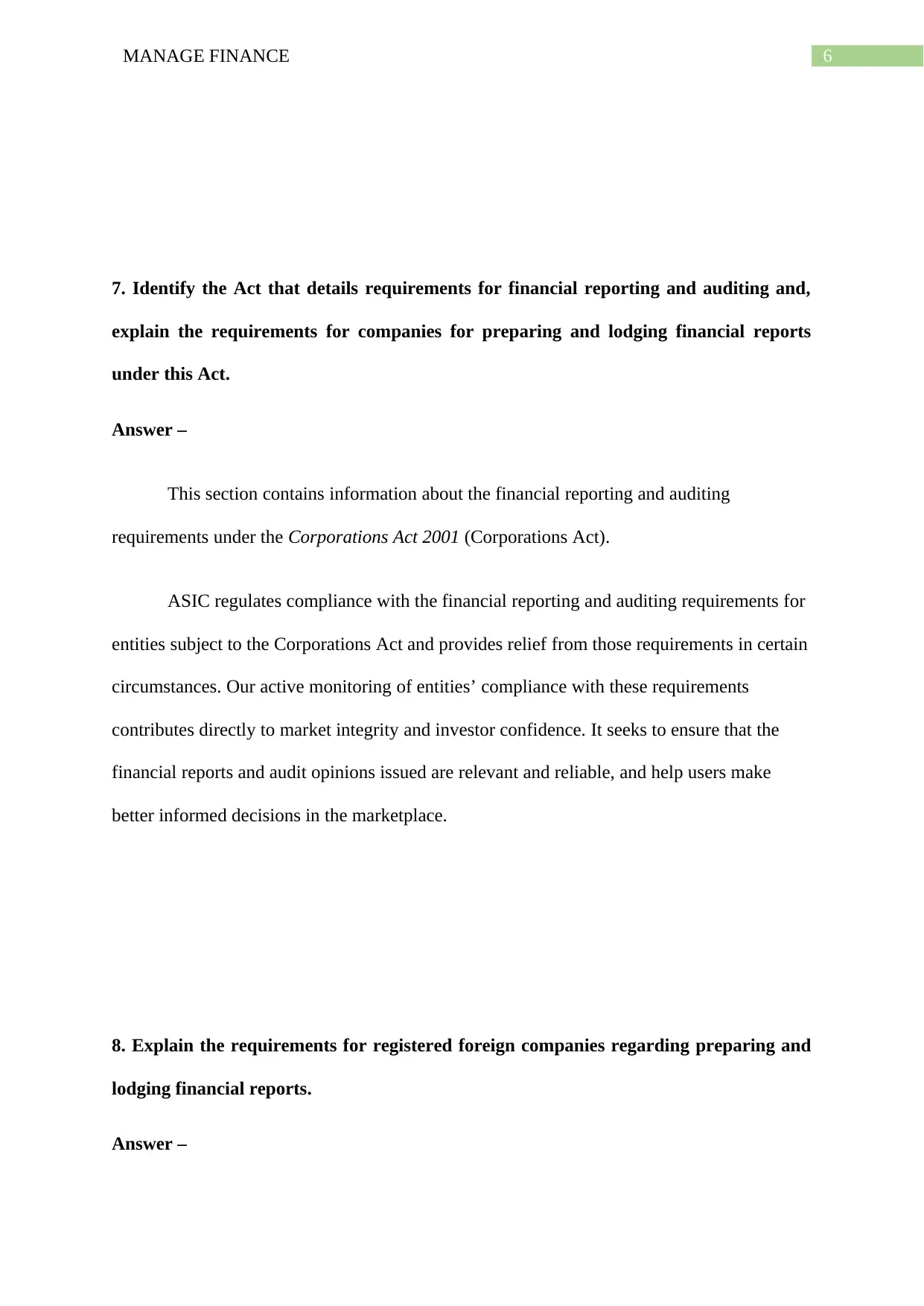
6MANAGE FINANCE
7. Identify the Act that details requirements for financial reporting and auditing and,
explain the requirements for companies for preparing and lodging financial reports
under this Act.
Answer –
This section contains information about the financial reporting and auditing
requirements under the Corporations Act 2001 (Corporations Act).
ASIC regulates compliance with the financial reporting and auditing requirements for
entities subject to the Corporations Act and provides relief from those requirements in certain
circumstances. Our active monitoring of entities’ compliance with these requirements
contributes directly to market integrity and investor confidence. It seeks to ensure that the
financial reports and audit opinions issued are relevant and reliable, and help users make
better informed decisions in the marketplace.
8. Explain the requirements for registered foreign companies regarding preparing and
lodging financial reports.
Answer –
7. Identify the Act that details requirements for financial reporting and auditing and,
explain the requirements for companies for preparing and lodging financial reports
under this Act.
Answer –
This section contains information about the financial reporting and auditing
requirements under the Corporations Act 2001 (Corporations Act).
ASIC regulates compliance with the financial reporting and auditing requirements for
entities subject to the Corporations Act and provides relief from those requirements in certain
circumstances. Our active monitoring of entities’ compliance with these requirements
contributes directly to market integrity and investor confidence. It seeks to ensure that the
financial reports and audit opinions issued are relevant and reliable, and help users make
better informed decisions in the marketplace.
8. Explain the requirements for registered foreign companies regarding preparing and
lodging financial reports.
Answer –
Paraphrase This Document
Need a fresh take? Get an instant paraphrase of this document with our AI Paraphraser
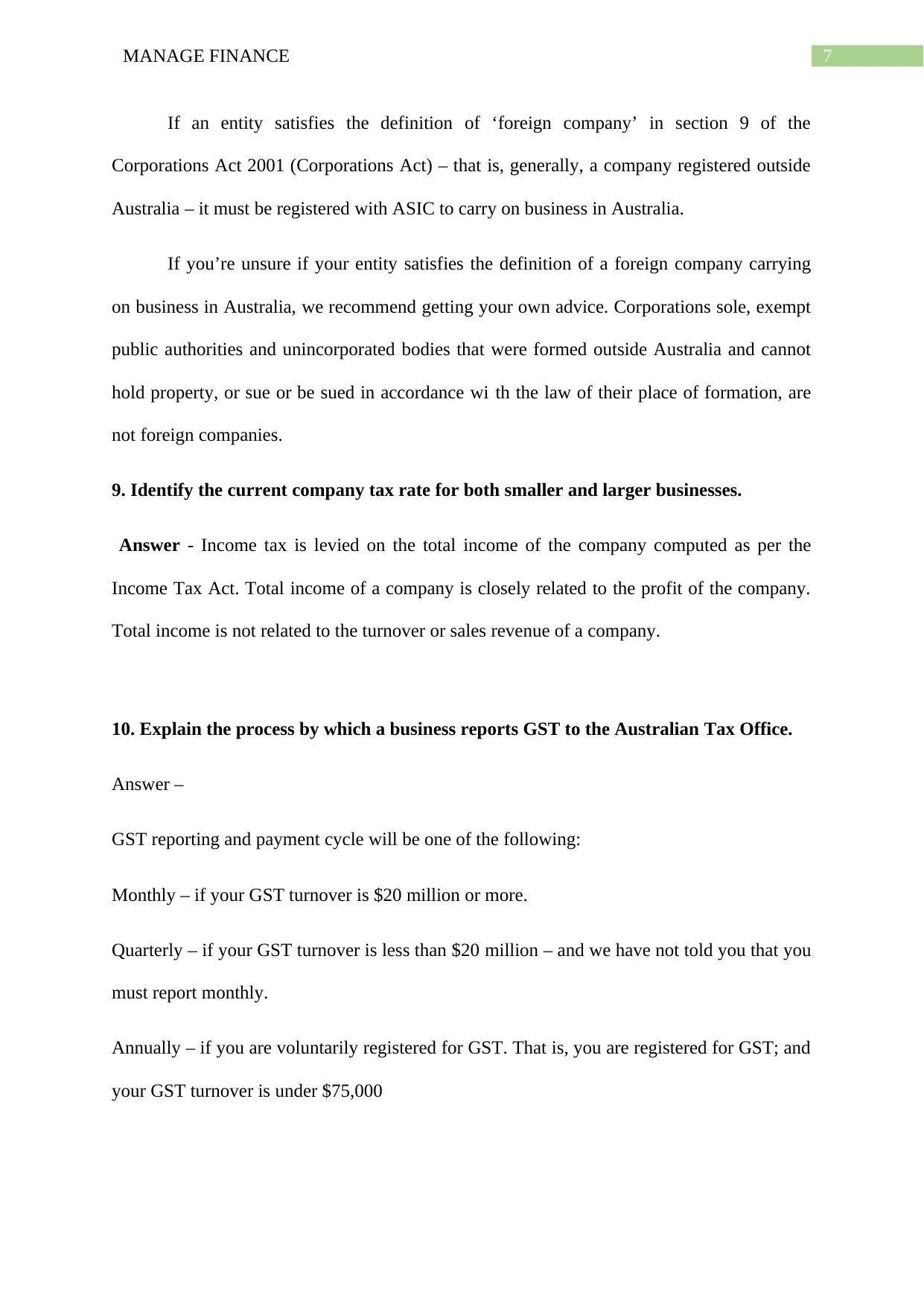
7MANAGE FINANCE
If an entity satisfies the definition of ‘foreign company’ in section 9 of the
Corporations Act 2001 (Corporations Act) – that is, generally, a company registered outside
Australia – it must be registered with ASIC to carry on business in Australia.
If you’re unsure if your entity satisfies the definition of a foreign company carrying
on business in Australia, we recommend getting your own advice. Corporations sole, exempt
public authorities and unincorporated bodies that were formed outside Australia and cannot
hold property, or sue or be sued in accordance wi th the law of their place of formation, are
not foreign companies.
9. Identify the current company tax rate for both smaller and larger businesses.
Answer - Income tax is levied on the total income of the company computed as per the
Income Tax Act. Total income of a company is closely related to the profit of the company.
Total income is not related to the turnover or sales revenue of a company.
10. Explain the process by which a business reports GST to the Australian Tax Office.
Answer –
GST reporting and payment cycle will be one of the following:
Monthly – if your GST turnover is $20 million or more.
Quarterly – if your GST turnover is less than $20 million – and we have not told you that you
must report monthly.
Annually – if you are voluntarily registered for GST. That is, you are registered for GST; and
your GST turnover is under $75,000
If an entity satisfies the definition of ‘foreign company’ in section 9 of the
Corporations Act 2001 (Corporations Act) – that is, generally, a company registered outside
Australia – it must be registered with ASIC to carry on business in Australia.
If you’re unsure if your entity satisfies the definition of a foreign company carrying
on business in Australia, we recommend getting your own advice. Corporations sole, exempt
public authorities and unincorporated bodies that were formed outside Australia and cannot
hold property, or sue or be sued in accordance wi th the law of their place of formation, are
not foreign companies.
9. Identify the current company tax rate for both smaller and larger businesses.
Answer - Income tax is levied on the total income of the company computed as per the
Income Tax Act. Total income of a company is closely related to the profit of the company.
Total income is not related to the turnover or sales revenue of a company.
10. Explain the process by which a business reports GST to the Australian Tax Office.
Answer –
GST reporting and payment cycle will be one of the following:
Monthly – if your GST turnover is $20 million or more.
Quarterly – if your GST turnover is less than $20 million – and we have not told you that you
must report monthly.
Annually – if you are voluntarily registered for GST. That is, you are registered for GST; and
your GST turnover is under $75,000
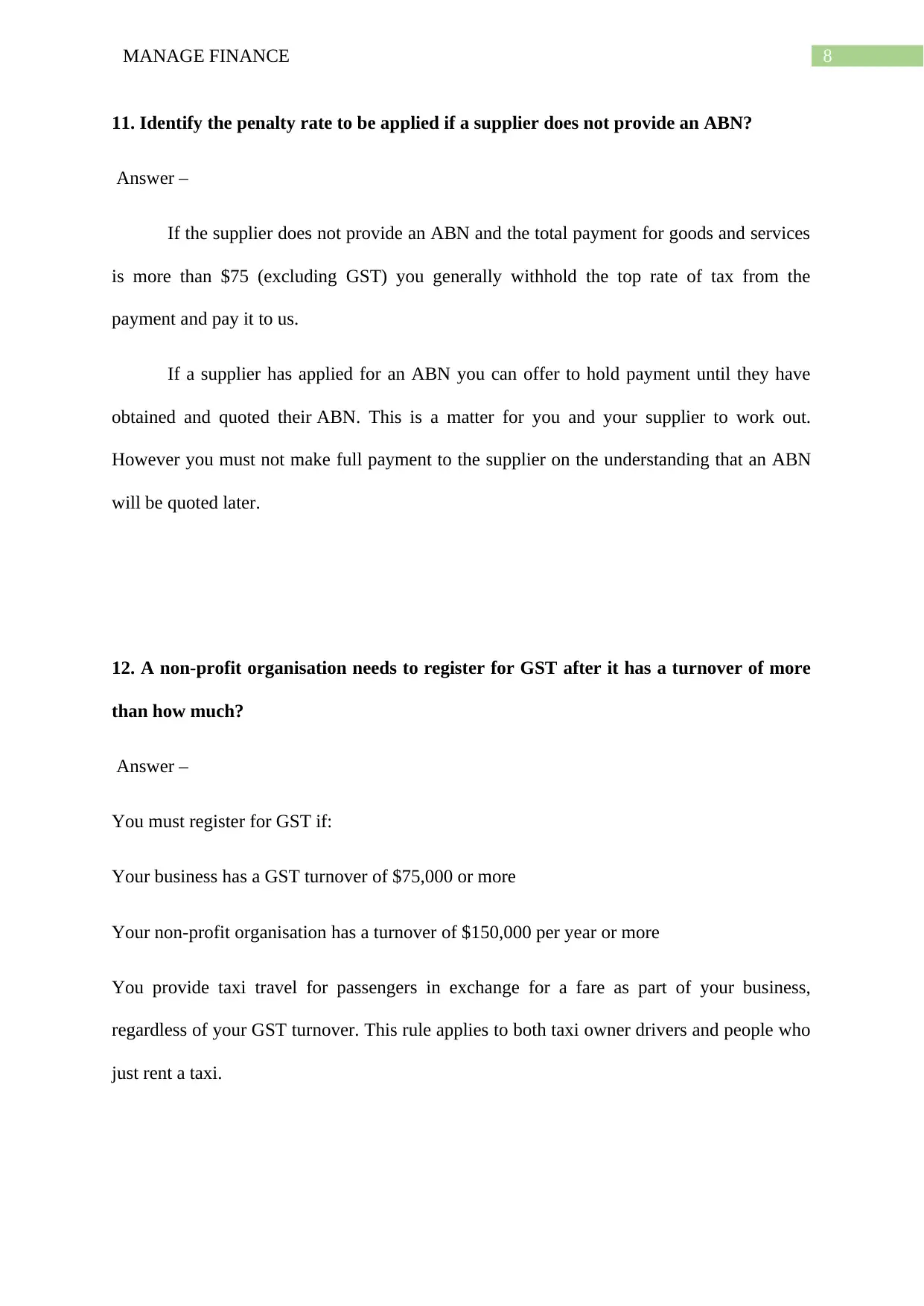
8MANAGE FINANCE
11. Identify the penalty rate to be applied if a supplier does not provide an ABN?
Answer –
If the supplier does not provide an ABN and the total payment for goods and services
is more than $75 (excluding GST) you generally withhold the top rate of tax from the
payment and pay it to us.
If a supplier has applied for an ABN you can offer to hold payment until they have
obtained and quoted their ABN. This is a matter for you and your supplier to work out.
However you must not make full payment to the supplier on the understanding that an ABN
will be quoted later.
12. A non-profit organisation needs to register for GST after it has a turnover of more
than how much?
Answer –
You must register for GST if:
Your business has a GST turnover of $75,000 or more
Your non-profit organisation has a turnover of $150,000 per year or more
You provide taxi travel for passengers in exchange for a fare as part of your business,
regardless of your GST turnover. This rule applies to both taxi owner drivers and people who
just rent a taxi.
11. Identify the penalty rate to be applied if a supplier does not provide an ABN?
Answer –
If the supplier does not provide an ABN and the total payment for goods and services
is more than $75 (excluding GST) you generally withhold the top rate of tax from the
payment and pay it to us.
If a supplier has applied for an ABN you can offer to hold payment until they have
obtained and quoted their ABN. This is a matter for you and your supplier to work out.
However you must not make full payment to the supplier on the understanding that an ABN
will be quoted later.
12. A non-profit organisation needs to register for GST after it has a turnover of more
than how much?
Answer –
You must register for GST if:
Your business has a GST turnover of $75,000 or more
Your non-profit organisation has a turnover of $150,000 per year or more
You provide taxi travel for passengers in exchange for a fare as part of your business,
regardless of your GST turnover. This rule applies to both taxi owner drivers and people who
just rent a taxi.
⊘ This is a preview!⊘
Do you want full access?
Subscribe today to unlock all pages.

Trusted by 1+ million students worldwide
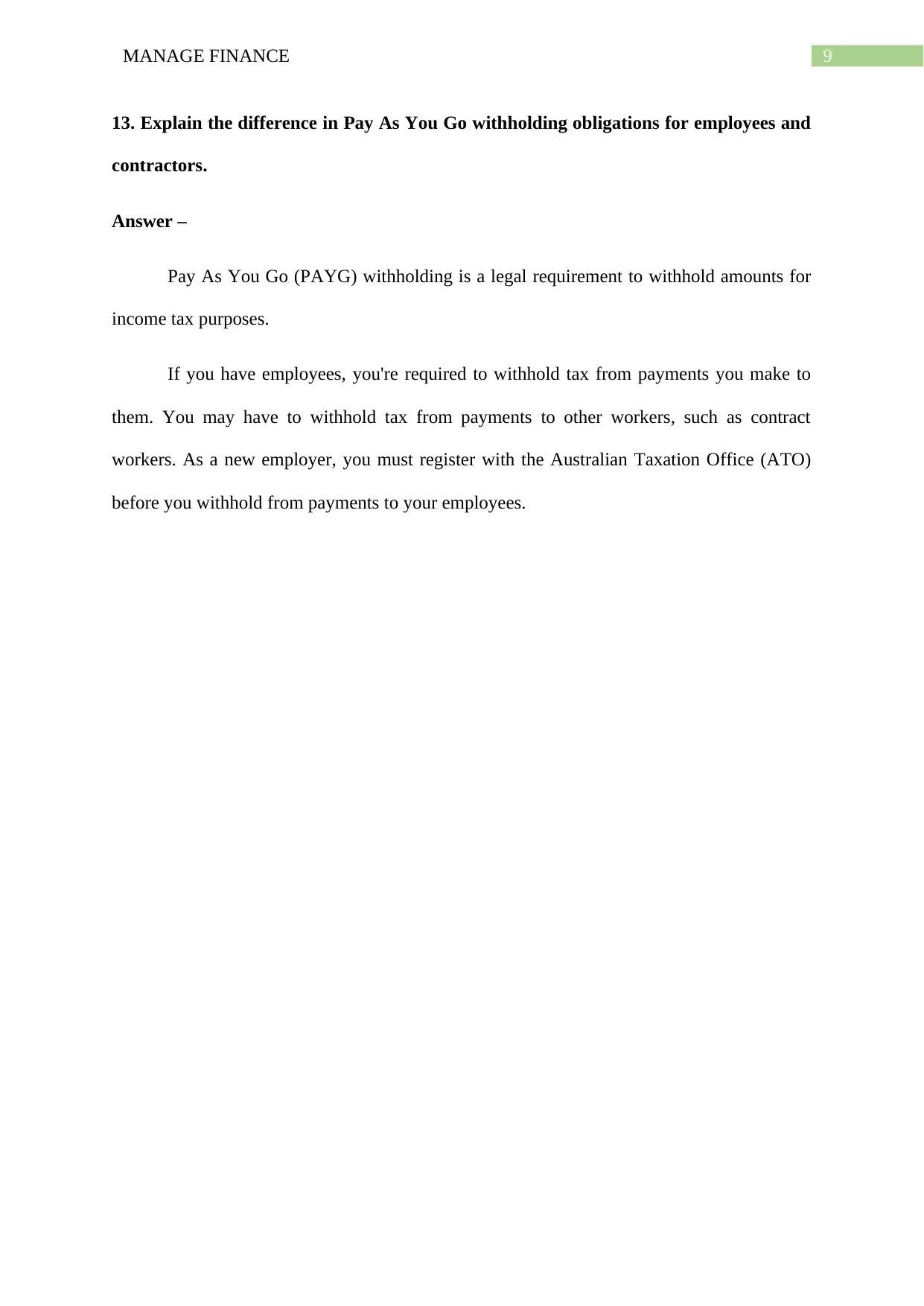
9MANAGE FINANCE
13. Explain the difference in Pay As You Go withholding obligations for employees and
contractors.
Answer –
Pay As You Go (PAYG) withholding is a legal requirement to withhold amounts for
income tax purposes.
If you have employees, you're required to withhold tax from payments you make to
them. You may have to withhold tax from payments to other workers, such as contract
workers. As a new employer, you must register with the Australian Taxation Office (ATO)
before you withhold from payments to your employees.
13. Explain the difference in Pay As You Go withholding obligations for employees and
contractors.
Answer –
Pay As You Go (PAYG) withholding is a legal requirement to withhold amounts for
income tax purposes.
If you have employees, you're required to withhold tax from payments you make to
them. You may have to withhold tax from payments to other workers, such as contract
workers. As a new employer, you must register with the Australian Taxation Office (ATO)
before you withhold from payments to your employees.
Paraphrase This Document
Need a fresh take? Get an instant paraphrase of this document with our AI Paraphraser
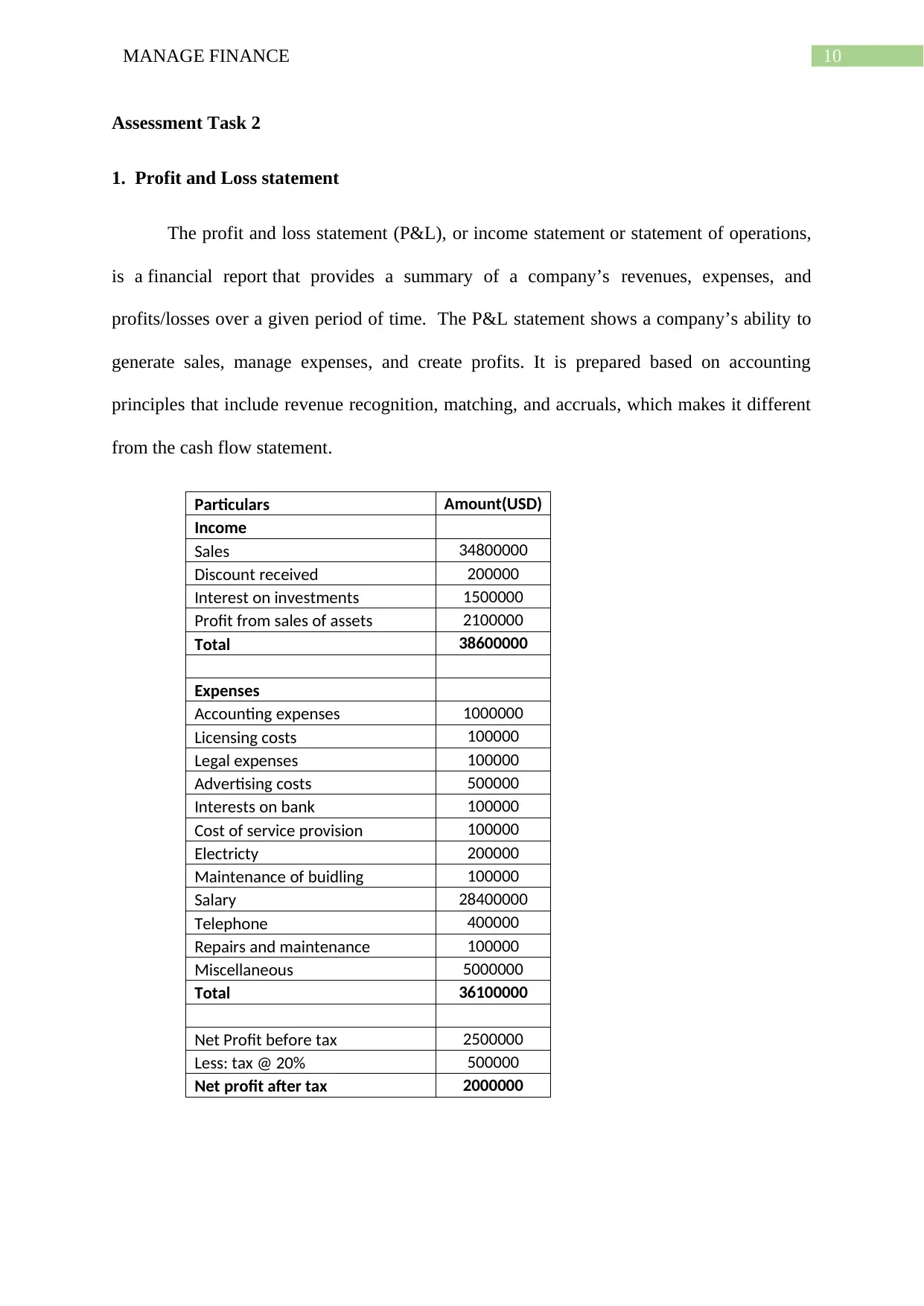
10MANAGE FINANCE
Assessment Task 2
1. Profit and Loss statement
The profit and loss statement (P&L), or income statement or statement of operations,
is a financial report that provides a summary of a company’s revenues, expenses, and
profits/losses over a given period of time. The P&L statement shows a company’s ability to
generate sales, manage expenses, and create profits. It is prepared based on accounting
principles that include revenue recognition, matching, and accruals, which makes it different
from the cash flow statement.
Particulars Amount(USD)
Income
Sales 34800000
Discount received 200000
Interest on investments 1500000
Profit from sales of assets 2100000
Total 38600000
Expenses
Accounting expenses 1000000
Licensing costs 100000
Legal expenses 100000
Advertising costs 500000
Interests on bank 100000
Cost of service provision 100000
Electricty 200000
Maintenance of buidling 100000
Salary 28400000
Telephone 400000
Repairs and maintenance 100000
Miscellaneous 5000000
Total 36100000
Net Profit before tax 2500000
Less: tax @ 20% 500000
Net profit after tax 2000000
Assessment Task 2
1. Profit and Loss statement
The profit and loss statement (P&L), or income statement or statement of operations,
is a financial report that provides a summary of a company’s revenues, expenses, and
profits/losses over a given period of time. The P&L statement shows a company’s ability to
generate sales, manage expenses, and create profits. It is prepared based on accounting
principles that include revenue recognition, matching, and accruals, which makes it different
from the cash flow statement.
Particulars Amount(USD)
Income
Sales 34800000
Discount received 200000
Interest on investments 1500000
Profit from sales of assets 2100000
Total 38600000
Expenses
Accounting expenses 1000000
Licensing costs 100000
Legal expenses 100000
Advertising costs 500000
Interests on bank 100000
Cost of service provision 100000
Electricty 200000
Maintenance of buidling 100000
Salary 28400000
Telephone 400000
Repairs and maintenance 100000
Miscellaneous 5000000
Total 36100000
Net Profit before tax 2500000
Less: tax @ 20% 500000
Net profit after tax 2000000
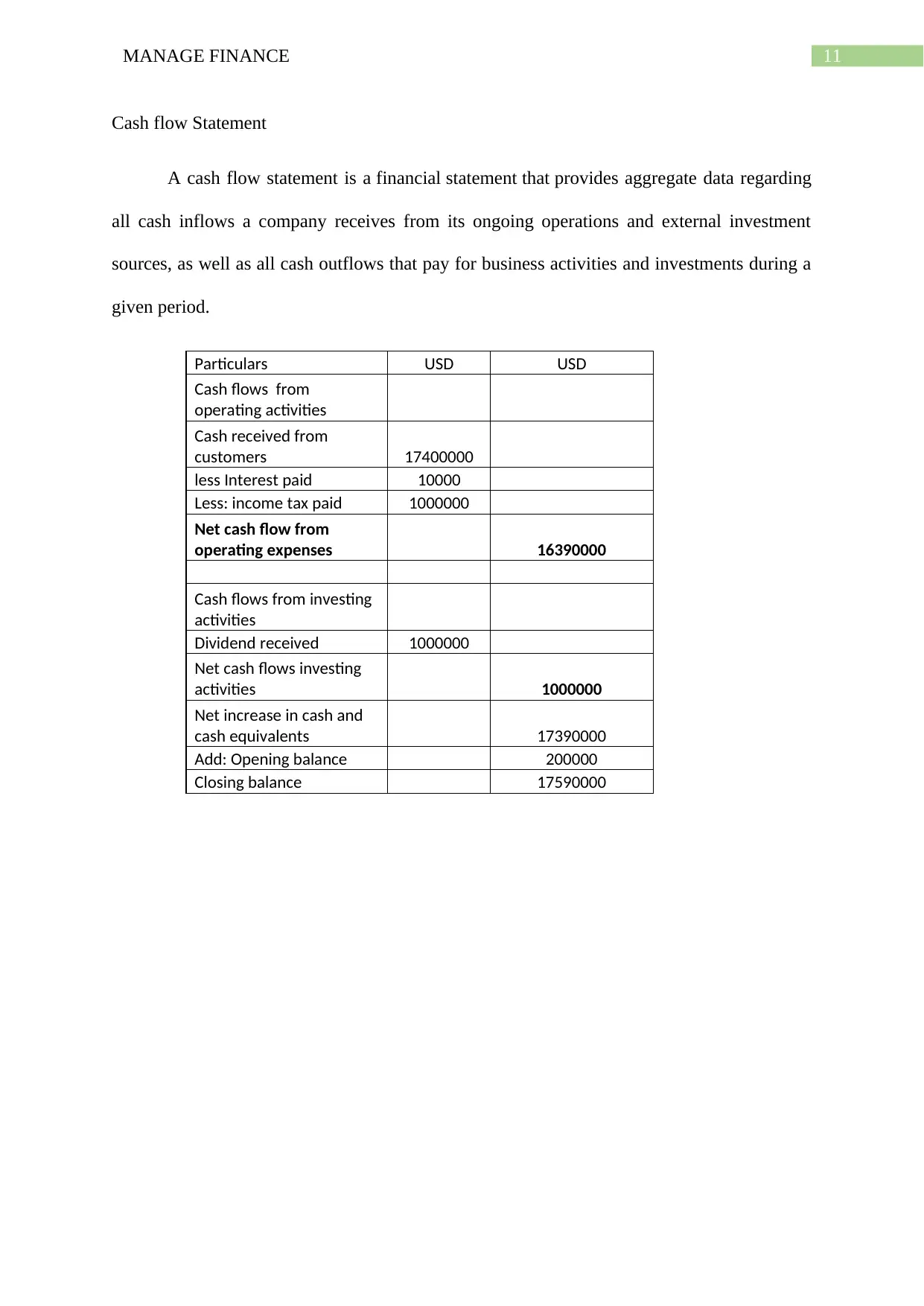
11MANAGE FINANCE
Cash flow Statement
A cash flow statement is a financial statement that provides aggregate data regarding
all cash inflows a company receives from its ongoing operations and external investment
sources, as well as all cash outflows that pay for business activities and investments during a
given period.
Particulars USD USD
Cash flows from
operating activities
Cash received from
customers 17400000
less Interest paid 10000
Less: income tax paid 1000000
Net cash flow from
operating expenses 16390000
Cash flows from investing
activities
Dividend received 1000000
Net cash flows investing
activities 1000000
Net increase in cash and
cash equivalents 17390000
Add: Opening balance 200000
Closing balance 17590000
Cash flow Statement
A cash flow statement is a financial statement that provides aggregate data regarding
all cash inflows a company receives from its ongoing operations and external investment
sources, as well as all cash outflows that pay for business activities and investments during a
given period.
Particulars USD USD
Cash flows from
operating activities
Cash received from
customers 17400000
less Interest paid 10000
Less: income tax paid 1000000
Net cash flow from
operating expenses 16390000
Cash flows from investing
activities
Dividend received 1000000
Net cash flows investing
activities 1000000
Net increase in cash and
cash equivalents 17390000
Add: Opening balance 200000
Closing balance 17590000
⊘ This is a preview!⊘
Do you want full access?
Subscribe today to unlock all pages.

Trusted by 1+ million students worldwide
1 out of 18
Related Documents
Your All-in-One AI-Powered Toolkit for Academic Success.
+13062052269
info@desklib.com
Available 24*7 on WhatsApp / Email
![[object Object]](/_next/static/media/star-bottom.7253800d.svg)
Unlock your academic potential
Copyright © 2020–2025 A2Z Services. All Rights Reserved. Developed and managed by ZUCOL.

![BSBFIM601 Manage Finances: Assessment Report, [Semester], [College]](/_next/image/?url=https%3A%2F%2Fdesklib.com%2Fmedia%2Fimages%2Fxm%2F162b9d69229e4e1db10d1eff3736f19c.jpg&w=256&q=75)



